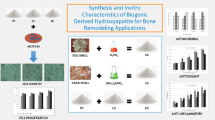Abstract
Osteomyelitis is an acute or chronic bone infection and inflammation caused by pyogenic organisms like bacteria. Treatment includes surgery and intake of antibiotics for a prolonged time. This work aims to provide a novel composite material which is cost-effective and reduces the dosage of antibiotics by implanting at the targeted site to eradicate the disease. Hydroxyapatite (HAp) Ca10(PO4)6(OH)2 extracted from oyster shell is used to improve the biocompatibility of the composite and recycling of the waste shell reduces the environmental pollution. Ciprofloxacin loaded hydroxyapatite/chitosan composite is synthesized and characterized to mimic the natural bone compositions. The prepared composite material is characterized by X-ray diffraction (XRD), Fourier transform infrared spectrometer (FTIR), thermo-gravimetric analysis (TGA-DTA), and scanning electron microscope (SEM) and energy dispersive X-ray spectroscopy (EDS). The XRD results show the prepared HAp is in good agreement with the JCPDS 076–0694 with standard peaks and crystalline structure. FTIR results confirm the presence of hydroxyapatite in both HAp powder and composite film, with the peaks corresponding to the absorption bands of phosphate and hydroxyl functional groups. Thermo-gravimetric analysis (TGA-DTA) is carried out to estimate the stability of HAp powder synthesized from oyster shell and film composite at higher temperatures. TGA is analyzed between 0 and 1000 °C, and it shows minimal weight loss till 700 °C for both HAp powder and composite film. SEM EDS has revealed the surface morphology and the chemical elements to validate the presence of hydroxyapatite, chitosan, and ciprofloxacin in the composite film. In-vitro degradation and drug release results show a sustained degradation and drug release of the film when immersed in the PBS solution. The MTT assay direct method test using L929 cell lines shows good biocompatibility with cell growth for the prepared HAp/chitosan/ciprofloxacin composite film.









Similar content being viewed by others
Data Availability
The data presented in this study are available on request from the corresponding author.
References
Schlickewei, C.W., Yarar, S., Rueger, J.M.: Eluting antibiotic bone graft substitutes for the treatment of osteomyelitis in long bones. A review: evidence for their use? Orthop. Res. Rev. 6, 71–79 (2014). https://doi.org/10.2147/ORR.S44747
Fritz, J.M., McDonald, J.R.: Osteomyelitis: approach to diagnosis and treatment. Phys. Sportsmed. (2008). https://doi.org/10.3810/psm.2008.12.11
Birt, M.C., Anderson, D.W., Bruce Toby, E., Wang, J.: Osteomyelitis: recent advances in pathophysiology and therapeutic strategies. J. Orthop. (2017). https://doi.org/10.1016/j.jor.2016.10.004
Simchi, A., Tamjid, E., Pishbin, F., Boccaccini, A.R.: Recent progress in inorganic and composite coatings with bactericidal capability for orthopaedic applications. Nanomed. Nanotech. Biol. Med. (2011). https://doi.org/10.1016/j.nano.2010.10.005
Soundrapandian, C., Sa, B., Datta, S.: Organic-inorganic composites for bone drug delivery. AAPS. PharmSciTech. (2009). https://doi.org/10.1208/s12249-009-9308-0
John, Ł.: Selected developments and medical applications of organic–inorganic hybrid biomaterials based on functionalized spherosilicates. Mater. Sci. Eng. C. (2018). https://doi.org/10.1016/j.msec.2018.02.007
Xu F.: Chemical and biochemical basis of cell-bone matrix interaction in health and disease. Curr. Chem. Biol. (2009). https://doi.org/10.2174/187231309788166398
Gong, T., Xie, J., Liao, J., Zhang, T., Lin, S., Lin, Y.: Nanomaterials and bone regeneration. Bone Res. 3, 15029 (2015). https://doi.org/10.1038/boneres.2015.29
Syauqina, A., Zaffarin, M., Ng, S., Ng, M.H., Hassan, H., Alias, E.: Nano-hydroxyapatite as a delivery system for promoting bone regeneration in vivo : a systematic review. Nanomaterials (Basel). 11(10), 2569 (2021). https://doi.org/10.3390/nano11102569
Rajan, M., Sumathra, M.: Biomedical applications of hydroxyapatite nanocomposites. Lect. Notes. Bioeng. (2019). https://doi.org/10.1007/978-3-030-04741-2_6
Londoño-Restrepo, S.M., Ramirez-Gutierrez, C.F., del Real, A., Rubio-Rosas, E., Rodriguez-García, M.E.: Study of bovine hydroxyapatite obtained by calcination at low heating rates and cooled in furnace air. J. Mater. Sci. (2016). https://doi.org/10.1007/s10853-016-9755-4
Goloshchapov, D.L., Kashkarov, V.M., Rumyantseva, N.A., et al.: Synthesis of nanocrystalline hydroxyapatite by precipitation using hen’s eggshell. Ceram. Int. (2013). https://doi.org/10.1016/j.ceramint.2012.11.050
Mustaffa, R., Mohd Yusof, M.R., Abdullah. Y.: A novelty of synthetic hydroxyapatite from cockle shell and characterization. Adv. Mater. Res. (2015). https://doi.org/10.4028/www.scientific.net/AMR.1087.429
Paul, S., Pal, A., Choudhury, A.R., et al.: Effect of trace elements on the sintering effect of fish scale derived hydroxyapatite and its bioactivity. Ceram. Int. (2017). https://doi.org/10.1016/j.ceramint.2017.08.127
Govindaraj, D., Rajan, M.: Synthesis and spectral characterization of novel nano-hydroxyapatite from moringaoleifera leaves. Mater. Today. Proc. (2016). https://doi.org/10.1016/j.matpr.2016.04.153
Teymouri, A., Stuart, B.J., Kumar, S.: Hydroxyapatite and dittmarite precipitation from algae hydrolysate. Algal. Res. (2018). https://doi.org/10.1016/j.algal.2017.11.030
Yang, Y., Yao, Q., Pu, X., Hou, Z., Zhang, Q.: Biphasic calcium phosphate macroporous scaffolds derived from oyster shells for bone tissue engineering. Chem. Eng. J. (2011). https://doi.org/10.1016/j.cej.2011.07.029
Bramhe, S.N., Lee, H.C., Chu, M.C., Ryu, J., Balakrishnan, A., Kim TN.: Facile synthesis of hydroxyapatite by hydrothermal and solvent combustion methods. Korean J. Mater. Res. (2015). https://doi.org/10.3740/MRSK.2015.25.9.492
Cesur, S., Oktar, F.N., Ekren, N., et al.: Preparation and characterization of electrospun polylactic acid / sodium alginate / orange oyster shell composite nanofiber for biomedical application. J. Aust. Ceram. Soc. (2019). https://doi.org/10.1007/s41779-019-00363-1
Brundavanam, R.K., Fawcett, D., Poinern, GEJ.: Synthesis of a bone like composite material derived from waste pearl oyster shells for potential bone tissue bioengineering applications. Int. J. Res. Med. Sci. (2017). https://doi.org/10.18203/2320-6012.ijrms20172428
Silva, T.H., Mesquita-Guimarães, J., Henriques, B.,et al.: The potential use of oyster shell waste in new value-added by-product. Resources. (2019). https://doi.org/10.3390/resources8010013
Bhattarai, N., Gunn, J., Zhang, M.: Chitosan-based hydrogels for controlled, localized drug delivery. Adv. Drug. Deliv. Rev. (2010). https://doi.org/10.1016/j.addr.2009.07.019
Kadouche, S., Farhat, M., Lounici, H., et al.: Low cost chitosan biopolymer for environmental use made from abundant shrimp wastes. Waste. Biomass. Valorization. (2017). https://doi.org/10.1007/s12649-016-9593-2
Levengood, S.K.L., Zhang, M.: Chitosan-based scaffolds for bone tissue engineering. J. Mater. Chem. B. (2014). https://doi.org/10.1039/c4tb00027g
Lee, Y.H., Kim, J.S., Kim, J.E., et al.: Nanoparticle mediated PPARγ gene delivery on dental implants improves osseointegration via mitochondrial biogenesis in diabetes mellitus rat model. Nanomed. Nanotech. Biol. Med. (2017). https://doi.org/10.1016/j.nano.2017.02.020
Bhattarai, G., Lee, Y.H, Lee, M.H., et al.: Insulin-like growth factor binding protein-3 affects osteogenic efficacy on dental implants in rat mandible. Mater. Sci. Eng. C. (2015). https://doi.org/10.1016/j.msec.2015.05.076
Bita, B., Stancu, E., Stroe, D., et al.: The effects of electron beam irradiation on the morphological and physicochemical properties of magnesium-doped hydroxyapatite/chitosancompositecoatings. Polymers. (2022). https://doi.org/10.3390/polym14030582
Ma, P., Wu, W., Wei, Y., et al.: Materials & design biomimetic gelatin / chitosan / polyvinyl alcohol / nano-hydroxyapatite scaffolds for bone tissue engineering. Mater. Des. (2021). https://doi.org/10.1016/j.matdes.2021.109865
Keser, S., Efe, H. Investigation of in vitro bioactivities of Zn-based hydroxyapatite samples doped with chitosan. J. Aust. Ceram. Soc. 57, 117–124 (2021). https://doi.org/10.1007/s41779-020-00519-4
Fraimow, H.: Systemic antimicrobial therapy in osteomyelitis. Semin. Plast. Surg. (2009). https://doi.org/10.1055/s-0029-1214161
Ghosh, S., Ghosh, S., Pramanik, N.: Bio-evaluation of doxorubicin (DOX)-incorporated hydroxyapatite (HAp)-chitosan (CS) nanocomposite triggered on osteosarcoma cells. Adv. Compos. Hybrid. Mater. (2020). https://doi.org/10.1007/s42114-020-00154-4
Uskoković, V., Desai, TA.: In vitro analysis of nanoparticulate hydroxyapatite/chitosan composites as potential drug delivery platforms for the sustained release of antibiotics in the treatment of osteomyelitis. J. Pharm. Sci. (2014). https://doi.org/10.1002/jps.23824
Günday, C., Anand, S., Gencer, H.B., et al.: Ciprofloxacin-loaded polymeric nanoparticles incorporated electrospun fibers for drug delivery in tissue engineering applications. Drug. Deliv. Transl. Res. (2020). https://doi.org/10.1007/s13346-020-00736-1
Seyhan, S.A., Alkaya, D.B., Cesur. S., et al.: Preparation and characterization of pure natural hydroxyapatite derived from seashells for controlled drug delivery. J. Aust. Ceram. Soc. (2022). https://doi.org/10.1007/s41779-022-00739-w.
Farnoush, S.R., Fariborz, S., Amirhossein, E.,et al.: Chitosan films and scaffolds for regenerative medicine applications: a review. Carbohydr. Polym. (2021). https://doi.org/10.1016/j.carbpol.2021.118631
Rujitanapanich, S., Kumpapan, P., Wanjanoi, P.: Synthesis of hydroxyapatite from oyster shell via precipitation. Energy. Procedia. (2014). https://doi.org/10.1016/j.egypro.2014.07.138
Hasan, M., Salam, K.A., Gafur, M.A, et al.: Chemical characteristics of hydroxyapatite from oyster shell by thermo-chemical process. Int. J. Innov. Res. Sci. Eng. Technol. (2015). https://doi.org/10.15680/ijirset.2015.0407002
Zhang, Y., Venugopal, J.R., El-Turki, A., et al.: Electrospun biomimetic nanocomposite nanofibers of hydroxyapatite/chitosan for bone tissue engineering. Biomaterials. (2008). https://doi.org/10.1016/j.biomaterials.2008.07.038
Nikpour, M.R., Rabiee, S.M., Jahanshahi, M.: Synthesis and characterization of hydroxyapatite/chitosan nanocomposite materials for medical engineering applications. Compos. Part. B. Eng. (2012). https://doi.org/10.1016/j.compositesb.2012.01.056
Parvez, S., Rahman, M.M., Khan, M.A., et al.: Preparation and characterization of artificial skin using chitosan and gelatin composites for potential biomedical application. Polym. Bull. (2012). https://doi.org/10.1007/s00289-012-0761-7
Nithya, R., Meenakshi Sundaram, N.: Biodegradation and cytotoxicity of ciprofloxacin-loaded hydroxyapatite-polycaprolactone nanocomposite film for sustainable bone implants. Int. J. Nanomedicine. (2015). https://doi.org/10.2147/IJN.S79995
Shi, C., Gao, J., Wang, M., et al.: Ultra-trace silver-doped hydroxyapatite with non-cytotoxicity and effective antibacterial activity. Mater. Sci. Eng. C. (2015). https://doi.org/10.1016/j.msec.2015.05.078
Kumar, C.S., et al.: Hydroxyapatite for bone related applications derived from sea shell waste by simpleprecipitation method. J. Asian. Ceram. Soc. 8(2), 416–429 (2020). https://doi.org/10.1080/21870764.2020.1749373
Thien, D.V. H., Thi, N., Thuyen, B., Thi, T., Quyen, B., and Chiem, N.H.: Microwave-assisted synthesis of nanorod hydroxyapatite from eggshells. Vietnam J. Sci. Technol. 63(1), 3–6 (2021). https://doi.org/10.31276/VJSTE.63(1).03-06.
Jalu, R.G., Chamada, T.A., and Kasirajan, R.: Calcium oxide nanoparticles synthesis from hen eggshells for removal of lead ( Pb ( II )) from aqueous solution. Environ. Challenges. (2021). https://doi.org/10.1016/j.envc.2021.100193
Mustafov, S.D., Sen, F., and Seydibeyoglu, M.O.: Preparation and characterization of diatomite and hydroxyapatite reinforced porous polyurethane foam biocomposites. Sci. Rep. (2020). https://doi.org/10.1038/s41598-020-70421-3
Wu, S., Gong, Y., Liu, S., Pei, Y., and Luo, X.: Functionalized phosphorylated cellulose microspheres: design, characterization and ciprofloxacin loading and releasing properties. Carbohydr. Polym. (2020). https://doi.org/10.1016/j.carbpol.2020.117421
Selvakumar, M., Thomas, S.: Chitosan-based nanocomposites for medical applications. J. Polym. Sci. (2021). https://doi.org/10.1002/pol.20210251
Liu, Y., Liu, M., Ji, S., Zhang, L., and Cao, W.: Preparation and application of hydroxyapatite extracted from fish scale waste using deep eutectic solvents. Ceram. Int. (2021).https://doi.org/10.1016/j.ceramint.2020.12.067
Li, X., Nan, K., Shi, S., Chen, H.: International Journal of Biological Macromolecules Preparation and characterization of nano-hydroxyapatite / chitosan cross-linking composite membrane intended for tissue engineering. Int. J. Biol. Macromol. (2012). https://doi.org/10.1016/j.ijbiomac.2011.09.021
Hahn, B., Park, D., Choi, J., et al.: Aerosol deposition of hydroxyapatite – chitosan composite coatings on biodegradable magnesium alloy. Surf. Coat. Technol. (2011). https://doi.org/10.1016/j.surfcoat.2010.11.029
Sobhani, Z., Mohammadi, S.S., Montaseri, H., et al.: Nanoparticles of chitosan loaded ciprofloxacin: fabrication and antimicrobial activity. Adv. Pharm. Bull. (2017). https://doi.org/10.15171/apb.2017.051
Venkatasubbu, D., Ramasamy, S., Ramakrishnan, V., et al.: Hydroxyapatite-alginate nanocomposite as drug delivery matrix for sustained release of ciprofloxacin. J. Biomed. Nanotechnol. (2011). https://doi.org/10.1166/jbn.2011.1350.
Hendradi, E., Hariyadi, D.M., and Adrianto, M.F.: The effect of two different crosslinkers on in vitro characteristics of ciprofloxacin-loaded chitosan implants. Res. Pharm. Sci. (2018). https://doi.org/10.4103/1735-5362.220966
Satpathy, A., Pal, A., Sengupta, S., et al.: Bioactive nano-hydroxyapatite doped electrospun PVA-chitosan composite nanofibers for bone tissue engineering applications. J. Indian. Inst. Sci. (2019). https://doi.org/10.1007/s41745-019-00118-8.
Sun, F., Pang, X., Zhitomirsky, I.: Electrophoretic deposition of composite hydroxyapatite–chitosan–heparincoatings. J. Mater. Process. Technol. (2008). https://doi.org/10.1016/j.jmatprotec.2008.04.007.
Acknowledgements
The authors express their gratitude to the management of Sri Ramakrishna Engineering College Coimbatore, Tamil Nadu, India, for allowing us to conduct this study.
Author information
Authors and Affiliations
Corresponding author
Ethics declarations
Conflict of interest
The authors declare no competing interests.
Additional information
Publisher's note
Springer Nature remains neutral with regard to jurisdictional claims in published maps and institutional affiliations.
Rights and permissions
Springer Nature or its licensor (e.g. a society or other partner) holds exclusive rights to this article under a publishing agreement with the author(s) or other rightsholder(s); author self-archiving of the accepted manuscript version of this article is solely governed by the terms of such publishing agreement and applicable law.
About this article
Cite this article
R, S., B, A.D. & N, M.S. Preparation of ciprofloxacin-loaded oyster shell derived hydroxyapatite composite film for biomedical applications. J Aust Ceram Soc 59, 621–632 (2023). https://doi.org/10.1007/s41779-023-00861-3
Received:
Revised:
Accepted:
Published:
Issue Date:
DOI: https://doi.org/10.1007/s41779-023-00861-3




